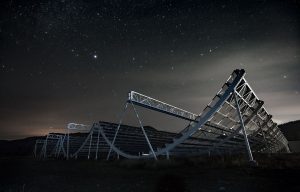CHIME radio telescope collaboration wins Brockhouse Canada Prize

The Canadian Hydrogen Intensity Mapping Experiment (CHIME) is a revolutionary new Canadian radio telescope designed to answer major questions in astrophysics. Photo: Andre Renard, Dunlap Institute; CHIME.
A cross-Canada collaboration including the University of Toronto has won the prestigious Brockhouse Canada Prize for Interdisciplinary Research in Science and Engineering from the National Science and Engineering Research Council (NSERC).
The Canadian Hydrogen Intensity Mapping Experiment (CHIME) is a groundbreaking radio telescope — one of the most novel and extraordinarily powerful in the world — located at the Dominion Radio Astrophysical Observatory in B.C. It is described by NSERC as “one of the biggest success stories in Canadian astrophysics.”
The CHIME team comprises world leaders in cosmology, pulsars, high-energy astrophysics and galactic emission. It includes researchers from McGill University, the University of British Columbia (UBC), the Perimeter Institute for Theoretical Physics and the National Research Council.
“CHIME’s success arose from thinking outside the box and innovating without constraints of convention,” says Ue-Li Pen, a professor in the Faculty of Arts & Science’s Canadian Institute for Theoretical Astrophysics and a CHIME member. “The experiment leveraged leading Canadian expertise across the country to implement the novel cosmological intensity mapping concept pioneered in Toronto. The ambitious wide field cylinder survey telescope turned out to be uniquely positioned to revolutionize the new Fast Radio Burst (FRB) field and has resulted in seven Nature papers since 2019.”
Unlike traditional telescopes that mechanically point to and observe a small region of the sky, this revolutionary technology scans the entire overhead sky each day by digitally processing the information received on a compact array of 2048 radio receivers as the Earth rotates.
The CHIME team’s breakthroughs are having an enormous impact in many areas, including dark energy and beyond. The telescope’s large collecting area, wide bandwidth and enormous field of view make it the world’s foremost instrument for detecting Fast Radio Bursts (FRBs) — brief bursts of radio waves coming from far beyond our Milky Way galaxy — and a vastly improved tool for measuring the cadence of pulsars, the best “clocks” in the universe.
The CHIME team has also created a progressive training environment for students, postdoctoral fellows and research associates. The team includes members of underrepresented groups in physics.
“It’s great to see the CHIME team rewarded for their innovative science and instrumentation,” says Juna Kollmeier, director of CITA. “Astronomical experiments require a synergy between theory, observation and instrumentation and the CHIME project represents the very best of all three of these branches. This grant will allow the team to continue to use novel instruments to reveal unsolved mysteries of the cosmos. Congratulations to the team!”
Read the full story here.
More information:
- UofT Celebrates: CHIME radio telescope collaboration wins Brockhouse Canada Prize (UofT)
- Brockhouse Canada Prize for Interdisciplinary Research in Science and Engineering (NSERC)
- CHIME team wins Brockhouse Canada Prize, CIFAR members among recipients (CIFAR)
- Canadian team wins prestigious award for work unravelling some of the mysteries of our universe (CBC)